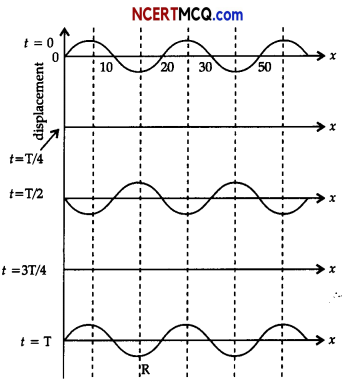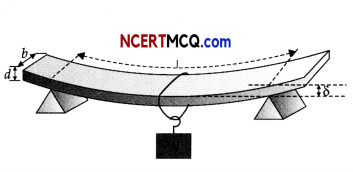Students can access the CBSE Sample Papers for Class 11 Physics with Solutions and marking scheme Term 2 Set 4 will help students in understanding the difficulty level of the exam.
CBSE Sample Papers for Class 11 Physics Standard Term 2 Set 4 for Practice
Time Allowed: 2 Hours
Maximum Marks: 40
General Instructions:
- There are 12 questions in all. All questions are compulsory.
- This question paper has three sections: Section A, Section B and Section C.
- Section A contains three questions of two marks each, Section B contains eight questions of three marks each, Section C contains one case study-based question of five marks.
- There is no overall choice. However, an internal choice has been provided in one question of two marks and two questions of three marks. You have to attempt only one of the choices in such questions.
- You may use log tables if necessary but use of calculator is not allowed.
Section – A (2 Marks Each)
Question 1.
The excess pressure inside a soap bubble is thrice the excess pressure inside a ’second soap bubble. What is the ratio of volume of two bubbles ?
Question 2.
Why a thick glass tumbler cracks when boiling water is poured in it ?
OR
An alloy consist of n metals of masses m1 m2 m3 …, mn and specific heat capacities c1 c2, c3 …cn. If the specific heat capacity of alloy is c, then calculate c.
Question 3.
What is an ‘Indicator diagram’ ? What is its importance ?
Section – B (3 Marks Each)
![]()
Question 4.
Define the coefficient of thermal conductivity.
Question 5.
Consider a cycle tyre being filled with air by a pump. Let V be the volume of the tyre (fixed) and at each stroke of the pump ΔV(« V) of air is transferred to the tube adiabatically. What is the work done when the pressure in the tube is increased from P1 to P2 ?
Question 6.
Calculate the average kinetic energy for one molecule of a gas at constant volume.
Question 7.
The periodic time of a mass suspended by a spring (force constant k) is T If the spring is cut in three equal pieces, what will be the force constant of each part? If the same mass be suspended from one piece, what will be the periodic time?
![]()
Question 8.
By using Stokes law, derive an expression for terminal velocity. On what factors does it depend ?
OR
An air bubble of radius r rises steadily through a liquid of density p at the rate of v. Neglecting density of air, find the coefficient of viscosity of liquid.
Question 9.
A particle in linear simple harmonic motion has a velocity of 4 ms-1 at 3 m at 3 ms-1 at 4 m from mean position. What is the time taken to travel half the amplitude from its positive extreme position ?
Question 10.
The wave pattern on a stretched string is shown in Fig. Interpret what kind of wave this is and find
its wavelength.

![]()
Question 11.
A steel wire has a length of 12 m and a mass of 2.10 kg. What will be the speed of a transverse wave on this wire when a tension of 2.06 × 104 N is applied?
OR
List the factors affecting the speed of sound in a gaseous medium.
Section – C (5 Marks)
Question 12.
Case Study: Sagging of a bridge
A bridge is designed such that it can withstand the load of the flowing traffic, the force of winds and its own weight.
Let us consider the case of a beam loaded at the centre and supported near its ends as shown in Figure.
A beam of length l, breadth b, and depth d when loaded at the centre by a load W sags by an amount given by
δ = \(\frac{W l^{3}}{4 b d^{3} Y}\)

From the equation, we see that to reduce the bending for a given load, one should use a material with a large Young’s modulus Y. For a given material, increasing the depth d rather than the breadth b is more effective in reducing the bending, since 8 is proportional to d-3 and to b-1 (of course the length l of the span should be as small as possible).
Amongst bridge materials, steel has the highest and most favorable strength qualities, and it is therefore suitable for the most daring bridges with the longest spans. Normal building steel has compressive and tensile strengths of 370 N/sq. mm, about ten times the compressive strength of a medium concrete and a hundred times its tensile strength. A special merit of steel is its ductility due to which it deforms considerably before it breaks, because it begins to yield above a certain stress level.
(i) To reduce bending of a beam
(a) For a given length and material, depth should be greater than breadth.
(b) For a given length and material, breadth should be greater than depth.
(c) For a given length and material, depth should be equal to breadth.
(d) Breadth and depth has no effect. [1]
(ii) Compressive strength of normal building steel is about ………………….. times of the compressive strength of medium concrete.
(a) 2
(b) 10
(c) 100
(d) 1000 [1]
(iii) What is the special merit of steel over concrete is its
(a) Malleability
(b) Brittleness
(c) Conductivity
(d) Ductility [1]
![]()
(iv) A bar of length l, breadth b, and depth d, supported at two ends when loaded at the centre by a load W sags by an amount given by
(a) δ = \(\frac{W l^{3}}{4 b d^{3} \mathrm{Y}}\)
(b) δ = \(\frac{W l}{4 b d^{3} \mathrm{Y}}\)
(c) δ = \(\frac{W l^{3}}{4 b^{3} d Y}\)
(d) δ = \(\frac{W Y l^{3}}{4 b d^{3}}\)
(v) Why ductility is the special merit of steel?
(a) Ductility allows structures to bend and deform to some extent without rupturing.
(b) Ductility offers the structure a high rigidity
(c) Ductility prevents the structure to sag while overloaded
(d) Ductility offers less corrosion